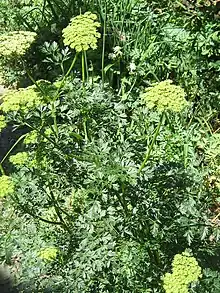Cenolophium
Cenolophium is a genus of flowering plants in the carrot family Apiaceae (Umbelliferae). Its only species is Cenolophium denudatum (known as Baltic parsley), native to Europe and Asia. A herbaceous perennial, it grows to 1.5 m (4.9 ft) tall by 0.5 m (1.6 ft) wide, with dark green divided leaves and, in summer, many umbels of tiny pale green or white flowers on branching naked stems (hence the Latin specific name denudatum).[1] The stems are sometimes purple in colour. The flowers are attractive to numerous insects.[2]
| Cenolophium | |
|---|---|
 | |
| Scientific classification | |
| Kingdom: | Plantae |
| Clade: | Tracheophytes |
| Clade: | Angiosperms |
| Clade: | Eudicots |
| Clade: | Asterids |
| Order: | Apiales |
| Family: | Apiaceae |
| Subfamily: | Apioideae |
| Genus: | Cenolophium W.D.J.Koch |
| Species: | C. denudatum |
| Binomial name | |
| Cenolophium denudatum | |
| Synonyms | |
| |
In cultivation in the UK, this plant has gained the Royal Horticultural Society’s Award of Garden Merit[2] (confirmed 2017).[3]
References
- Harrison, Lorraine (2012). RHS Latin for Gardeners. United Kingdom: Mitchell Beazley. ISBN 184533731X.
- "RHS Plantfinder - Cenolophium denudatum". Royal Horticultural Society. Retrieved 21 January 2018.
- "AGM Plants - Ornamental" (PDF). Royal Horticultural Society. July 2017. p. 17. Retrieved 24 January 2018.
Gallery
This article is issued from Wikipedia. The text is licensed under Creative Commons - Attribution - Sharealike. Additional terms may apply for the media files.


